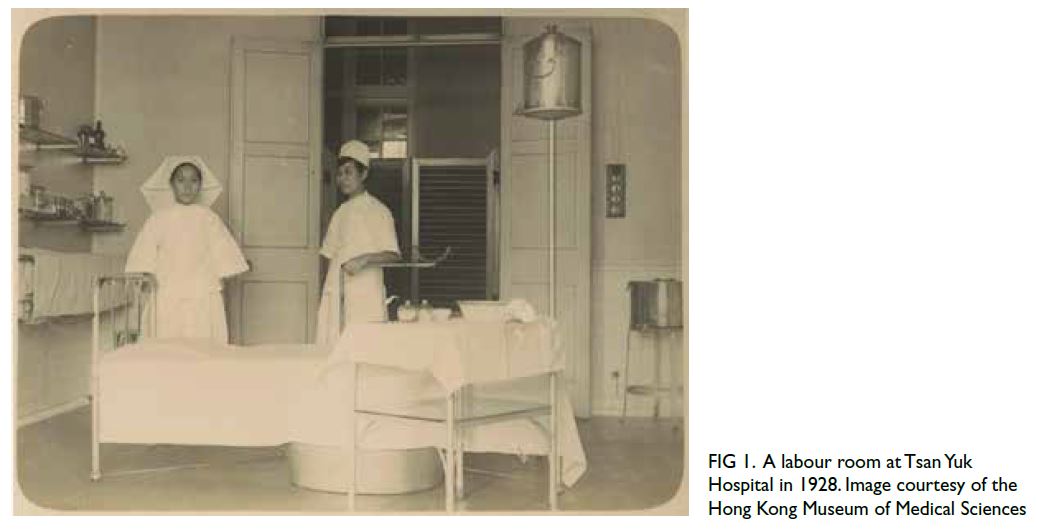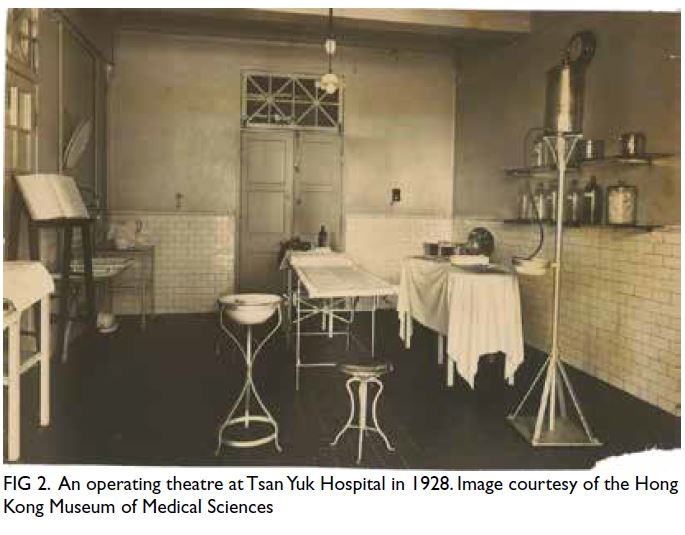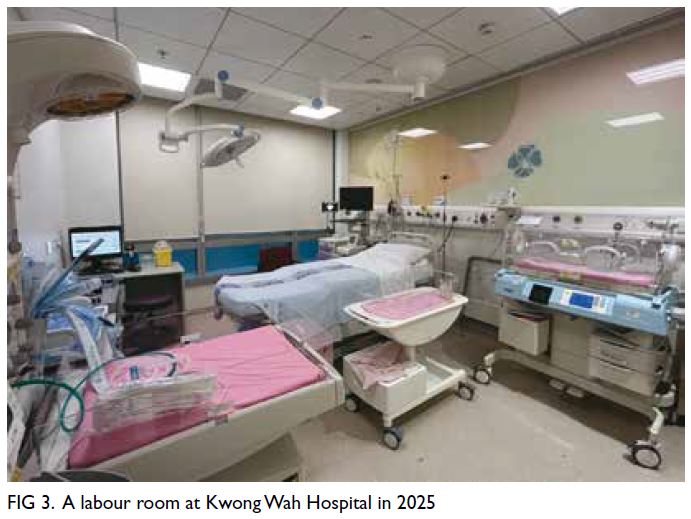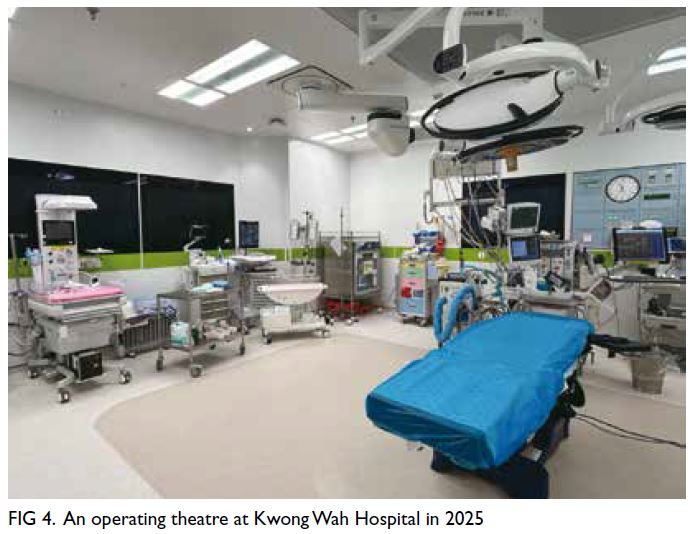© Hong Kong Academy of Medicine. CC BY-NC-ND 4.0
REMINISCENCE: ARTEFACTS FROM THE HONG KONG MUSEUM OF MEDICAL SCIENCES
Through the lens of history: century-old snapshots from Tsan Yuk Hospital
Stephanie Adams, MD, MWomHMed1; CP Lee, FRCOG, FHKAM (Obstetrics and Gynaecology)2 Elce Au Yeung, RNM, MN3; WC Leung, MD, FHKAM (Obstetrics and Gynaecology)1; Education and Research Committee, Hong Kong Museum of
Medical Sciences
1 Department of Obstetrics and Gynaecology, Kwong Wah Hospital, Hong Kong SAR, China
2 Department of Obstetrics and Gynaecology, Tsan Yuk Hospital, Hong Kong SAR, China
3 School of Midwifery, Department of Obstetrics and Gynaecology, Prince of Wales Hospital, Hong Kong SAR, China
Founded in 1922, Tsan Yuk Hospital celebrates its
103rd anniversary this year. As one of Hong Kong’s
first maternity hospitals, Tsan Yuk Hospital provided
safe, professional in-patient obstetric services to
women and their newborns until 3 November 2001,
when the last delivery occurred.1 Since then, Tsan
Yuk Hospital has transitioned from a standalone
maternity hospital to an out-patient centre focused
on antenatal care.1
In 1928, Prof Richard Edwin Tottenham, one
of the first obstetrics and gynaecology professors
to work at the hospital, published a clinical report
containing photographs of the then newly built
institution’s labour ward and the operating theatre
(Figs 1 and 2).2 Comparing these with their modern-day
equivalents (Figs 3 and 4) highlights the
advancement of obstetric care over the last century.

Figure 1. A labour room at Tsan Yuk Hospital in 1928. Image courtesy of the Hong Kong Museum of Medical Sciences

Figure 2. An operating theatre at Tsan Yuk Hospital in 1928. Image courtesy of the Hong Kong Museum of Medical Sciences
The 1920s labour room (Fig 1) was minimalist
compared to today’s. The focal point was a simple
bed, positioned in the room’s centre. Wall-mounted
shelves held glass jars and metal containers, likely filled with medications and consumables. Next to
the bed, there was a table upon which sat multiple
bowls. Most consumables were placed in a bowl. The
bowl itself would be used by one patient at a time
and disinfected between patients. The special metal
container held up by a pole next to the bed is thought
to be a water tank storing sterilised water, but this
has not been confirmed.
Figure 3 shows a current labour room in a
new Kwong Wah Hospital building that has been
operational since 2024. Unlike the relatively bare
1920s room, the modern labour room boasts
equipment to ensure the baby’s safety, including
a cardiotocography machine to monitor fetal
heartbeat, an incubator to keep the baby warm,
and a resuscitaire in case of neonatal resuscitation.
The electric bed can be adjusted for height and
dismantled in seconds for the mother to transition
into the lithotomy position. Mounted to the wall,
there is an emergency alarm, a suction device and
equipment providing oxygen or nitrous oxide. Bowls are obsolete as most consumables are now placed in
single-use plastic containers.
Figure 2 captures an operating theatre at Tsan
Yuk Hospital in the 1920s, while Figure 4 features
an operating theatre on the labour ward at Kwong
Wah Hospital. A hundred years ago, the theatre was
equipped with basic instruments and had limited
lighting. There were no anaesthetic machines or
monitoring equipment. Seen side by side, one can
appreciate the rapid development of medicine in
Hong Kong.
There were 1109 admissions to Tsan Yuk
Hospital and 537 admissions to the Government
Civil Hospital in 1928.2 In those days, before safe
anaesthesia and antibiotics, caesarean delivery
carried a very high risk. That year, only two caesarean
sections were performed in which both the women
and their babies survived.2 The low maternal
morbidity rate at Tsan Yuk Hospital in the 1920s can
be attributed to the enhanced hygiene resulting from
each patient having their own pan, bowl and chamber
pot at each bed, as Prof Tottenham reported.2
The introduction of anaesthesia changed the
labouring experience. In the 1920s, most mothers
laboured without any analgesia. However, inspired
by the use of rectal ether during their visit to the New
York Lying-In Hospital in the United States, doctors
at Tsan Yuk Hospital tested colonic ether on 27
primiparous women.2 The medication was a mixture
of olive oil, ether and paraldehyde, administered via
an enema at the start of labour. When the cervix
was almost fully dilated, an additional small dose
of morphine was injected through a rectal tube
into the colon. Pure olive oil would then be injected
into the tube, followed by more olive oil and ether,
with or without paraldehyde. Once labour ended,
the rectum was washed. Nowadays, most expectant
mothers would reject such a form of pain relief.
In fact, colonic ether is no longer used to alleviate
labour pain. Instead, many other pharmacological
and non-pharmacological options, such as an
epidural, nitrous oxide inhalation, injections and
childbirth massage, are available to manage the pain
of childbirth.
Prior to the introduction of Western medicine
in the late 19th century, traditional Chinese
medicine was mainstream.3 Most women chose to
deliver their babies at home and only presented at
hospital after exhausting their traditional Chinese
midwives’ treatment options.3 After giving birth,
women typically returned to their communities as
soon as possible.3 Yet this started to change around
1928 as Western medicine gained greater public
acceptance. According to Prof Tottenham’s report,2
more than 90% of postpartum patients stayed at
Tsan Yuk Hospital for a week, whereas a few years
prior, nursing staff were to be congratulated if
patients stayed for more than 3 days after delivery. A longer postpartum stay in hospital was considered
a safe practice in the 1920s, when sepsis rates were
high and most homes lacked a clean water supply.
The pendulum swung back in the 1980s, and early
discharge from hospital became the norm, owing
to improved housing and an increased demand for
maternity beds due to the influx of Vietnamese and mainland Chinese immigrants.3
Since its inception over a century ago, Tsan
Yuk Hospital has provided the highest-quality
obstetric care in Hong Kong. As we reflect on Tsan
Yuk Hospital’s remarkable legacy, may its history
continue to guide and inspire the future of maternal
care in Hong Kong.
References
1. Law BM, Hui PW. Tsan Yuk Hospital: a century of dedicated obstetrical service. Hong Kong J Gynaecol Obstet Midwifery 2023;23:135-9. Crossref
2. Tottenham RE, Pillai DK, Lam SK, Lai PC. Clinical report of the Tsan Yuk Hospital and of the Maternity Bungalow, Government Civil Hospital. Caduceus 1928;7:194-219.
3. Chow AW. Metamorphosis of Hong Kong midwifery. Hong Kong J Gynaecol Obstet Midwifery 2001;1:72-80.



